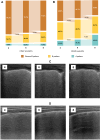Effect of different CPAP levels on ultrasound-assessed lung aeration and gas exchange in neonates
- PMID: 39420410
- PMCID: PMC11488124
- DOI: 10.1186/s12931-024-03010-x
Effect of different CPAP levels on ultrasound-assessed lung aeration and gas exchange in neonates
Erratum in
-
Correction: Effect of different CPAP levels on ultrasound-assessed lung aeration and gas exchange in neonates.Respir Res. 2025 Aug 6;26(1):258. doi: 10.1186/s12931-025-03333-3. Respir Res. 2025. PMID: 40770801 Free PMC article. No abstract available.
Abstract
Background: Respiratory distress syndrome (RDS) and transient tachypnoea (TTN) are the two commonest neonatal respiratory disorders. The optimal continuous positive airway pressure (CPAP) to treat them is unknown. We aim to clarify the effect of different CPAP levels on lung aeration and gas exchange in patients with RDS and TTN.
Methods: Prospective, observational, pragmatic, physiological cohort study. CPAP was sequentially increased from 4 to 6 and 8 cmH2O and backwards, with interposed wash-out periods. Lung aeration was assessed with a validated neonatal lung ultrasound score. Gas exchange was non-invasively evaluated with transcutaneous monitoring. Ultrasound score and PtcO2/FiO2 ratio were the co-primary outcomes. PtcCO2 and other oxygenation metrics were the secondary outcomes.
Results: 30 neonates with RDS and 30 with TTN were studied. Each CPAP increment significantly (overall always p < 0.001) improved both lung aeration and oxygenation, but the increase from 6 to 8 cmH2O achieved a small absolute benefit. In RDS patients, the absolute improvements were small and the diagnosis of TTN was significantly associated with greater improvement of lung aeration (β= -1.4 (95%CI: -2.4; -0.3), p = 0.01) and oxygenation (β = 39.6 (95%CI: 4.1; 75.1), p = 0.029). Aeration improved in 16 (53.3%) and 27 (90%) patients in the RDS and TTN groups, respectively (p = 0.034). Lung aeration showed significant hysteresis in TTN patients. Secondary outcomes gave similar results.
Conclusions: Increasing CPAP from 4 to 8 cmH2O improves ultrasound-assessed lung aeration and oxygenation in RDS and TTN. The absolute improvements are small when CPAP is beyond 6 cmH2O or for RDS patients.
Keywords: Infant; Respiratory distress syndrome; Surfactant; Transient tachypnoea of the neonate.
© 2024. The Author(s).
Conflict of interest statement
The authors declare no competing interests.
none.
Figures



References
-
- Pezza L, Sartorius V, Loi B, Regiroli G, Centorrino R, Lanciotti L, et al. Evolution of ultrasound-assessed lung aeration and gas exchange in respiratory distress syndrome and transient tachypnea of the neonate. J Pediatr. 2023;256:44–e522. 10.1016/j.jpeds.2022.11.037. - PubMed
-
- Diblasi RM. Nasal continuous positive airway pressure (CPAP) for the respiratory care of the newborn infant. Respir Care. 2009;54:1209–35. - PubMed
-
- Cavicchioli P, Zimmermann LJ, Cogo PE, Badon T, Giordano G, Torresin M, et al. Endogenous surfactant turnover in preterm infants with respiratory distress syndrome studied with stable isotope lipids. Am J Respir Crit Care Med. 2001;163:55–60. - PubMed
Publication types
MeSH terms
LinkOut - more resources
Full Text Sources

